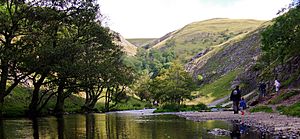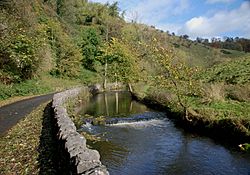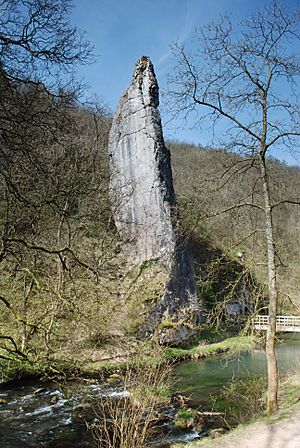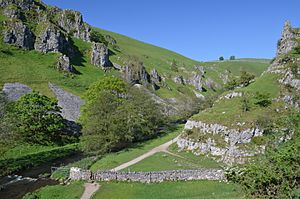Dovedale facts for kids
Quick facts for kids Dovedale |
|
|---|---|
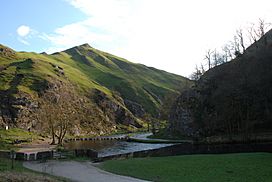
Thorpe Cloud and Stepping Stones, Dovedale
|
|
| Geography | |
| Location | England, Staffordshire, Derbyshire |
| Rivers | River Dove |
Dovedale is a beautiful valley in the Peak District, England. The National Trust owns this land. About a million people visit Dovedale every year.
The River Dove carved out this valley. It stretches for about 5 kilometers (3 miles). You can find it between Milldale in the north and a wooded area near Thorpe Cloud and Bunster Hill in the south. In the wooded part, there are famous stepping stones across the river. You can also find two caves called the Dove Holes.
Dovedale has other cool spots too. These include tall rock pillars like Ilam Rock. There's also Viator's Bridge, and interesting limestone shapes like Lovers' Leap and Reynard's Cave.
Contents
How Dovedale Was Formed
The rocks in Dovedale are made of limestone. This limestone formed from the remains of sea creatures. They lived in a shallow sea about 350 million years ago. This was during the Carboniferous period.
During two ice ages, melting ice carved the limestone. This created the craggy shapes you see today. Dry caves like Dove Holes and Reynard's Kitchen Cave also formed then.
A Look Back in Time
People have used the caves in Dovedale for a very long time. Hunters used them as shelters about 13,000 years ago. So, people have been active in Dovedale ever since.
Around 4,500 years ago, Neolithic farmers used the caves as tombs. There is also proof of Bronze Age activity in Reynard's Cave. Items found there are now on display at the Buxton Museum and Art Gallery.
Vikings settled in this area around 800 CE. Some local place names, like Thorpe, come from Scandinavia. These settlements became permanent. Thorpe is even mentioned in the Domesday Book from 1086.
Viator's Bridge in Milldale is a very old packhorse bridge. It has been used since the Middle Ages. People used it to transport goods like silks and flax from nearby Wetton and Alstonefield.
People started visiting Dovedale for fun in the 1700s. Now, Dovedale is one of the most visited natural places in Britain.
In 2014, a collection of Iron Age and Roman coins was found. They were discovered in Reynard's Kitchen Cave. There were 26 coins in total. Three were Roman coins from before the Roman invasion of Britain. The other 20 were gold and silver coins from the Late Iron Age. They are thought to belong to the Corieltavi tribe. An archaeologist from the National Trust said these coins showed "a serious amount of wealth and power." The coins were planned to be shown at Buxton Museum.
The River Dove
The River Dove is famous for its trout fishing. It is 45 miles long. Charles Cotton's Fishing House stands by the river. This house inspired Izaak Walton's famous book, The Compleat Angler.
From Hartington to where it meets the River Manifold at Ilam, the River Dove flows through a beautiful limestone valley. This valley is known as Dove Valley or Dovedale. The river flows through several dales, including Beresford Dale, Wolfscote Dale, Milldale, and then Dovedale.
The National Trust's Role
The National Trust owns much of Dovedale. They bought Dovedale in 1934. They added more land until 1938, and Wolfscote Dale in 1948.
Dovedale became a National Nature Reserve in 2006. This was because it is "one of England's finest wildlife sites." It has many different plants and interesting rock shapes.
In 2010, the National Trust worked with Derbyshire County Council. They updated Dovedale's famous stepping stones. They added mortar and limestone slabs to most of the stones.
Thorpe Cloud
At the south end of Dovedale, between the villages of Thorpe and Ilam, is Thorpe Cloud. It is a tall, isolated limestone hill, about 287 meters (942 feet) high. It's known as a reef knoll. From its top, you can see north up the valley and south across the Midlands. Its name "cloud" comes from an old English word meaning "hill."
On the other side of the river is Bunster Hill. It is taller, about 329 meters (1,079 feet) high, but less isolated. It is also a reef knoll. The National Trust bought both hills in 1934.
Milldale Village
Milldale is a village with stone cottages. It's at the north end of Dovedale. It's the main entry point to the valley from the north. There used to be a corn mill here until the mid-1800s. Its old stables are now used as an information hut by the National Trust.
Viator's Bridge
The old, narrow packhorse bridge at Milldale used to have no side walls. This was so horses with panniers (baskets) could cross easily. Izaak Walton wrote about it in his book The Compleat Angler. He called himself "Viator," which means "traveller" in Latin. He wrote:
"What’s here, the sign of a bridge? Do you travel in wheelbarrows in this country? This bridge was made for nothing else – why a mouse can hardly go over it, tis not two fingers broad!"
Because of this, the bridge became known as Viator's Bridge.
The bridge has been used since the Middle Ages. Packhorses carried silks and flax from nearby Wetton and Alstonefield over it. It is now listed as an ancient monument.
Amazing Limestone Rocks
Dovedale is famous for its many limestone rock formations. The first one you see from the south is Dovedale Castle. It's a short walk from the stepping stones.
The limestone cliff called Lover's Leap can be reached by steps. These steps were built by people captured during the Second World War. The National Trust now maintains them.
There's a sad story about Lover's Leap. A young woman thought her lover had died in the Napoleonic Wars. She jumped from the cliff. But her skirt caught on a tree branch, saving her life. When she got home, she learned her lover was alive. Other similar stories are told about Lover's Leap.
Across from Lover's Leap are the Twelve Apostles. These rock spires stick out from the valley side. The river has worn away the rock and soil around them. The National Trust keeps plants clear so you can see these formations.
Other notable rock formations include:
- Ravenstor
- Pickering Tor
- Tissington Spires
- Dovedale Church
- Reynard's Cave
- Lionshead Rock
- Ilam Rock
- Shepherd's Abbey
- Dove Holes
Nature and Wildlife
Dovedale is very important for its plant life. It has special ash woods that grow on calcium-rich soil. These woods are considered some of the best in England.
You can find unusual plants here. These include Solomon's seal, lily of the valley, herb-paris, and small and large-leaved lime trees. Birds like the common kingfisher, grey heron, and dipper also live here.
Visiting Dovedale
In the 1700s and 1800s, mostly wealthy people visited Dovedale. From 1899, a railway line ran to Thorpe Cloud station. This made Dovedale easier for everyone to visit. Better roads also made travel simpler.
In 1931, the government suggested creating National Parks. Dovedale was chosen as one of these areas. It became part of the Peak District National Park in 1951. This was Britain's first National Park.
In 1937, a railway line was turned into a paved path called Manifold Way. Another railway line closed in the 1960s. It became a walking path called Tissington Trail.
A survey in 1986/87 showed that walking was the main reason people visited. On one Sunday in 1990, nearly 8,000 walkers were counted on the riverside paths. These paths make the valley easy to explore.
Fishing has also become popular. This is partly because of Izaak Walton's book, The Compleat Angler. Some fishing rights are held by the Izaak Walton Hotel.
With more visitors, Dovedale sometimes faces problems. These include crowded areas and damage to the paths from too much walking.
Dovedale in Books and Movies
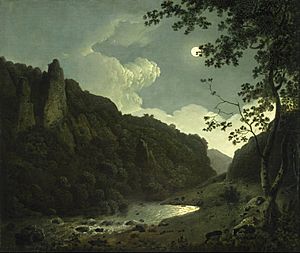
Charles Cotton's Fishing House, which inspired Izaak Walton's The Compleat Angler, is by the River Dove.
Famous writers like Samuel Johnson, Lord Tennyson, John Ruskin, and Lord Byron all loved Dovedale's beauty. Lord Byron even wrote that Dovedale had things "as noble as Greece or Switzerland."
In Jane Austen's book Pride and Prejudice, Elizabeth Bennet and Mr. Darcy talk about her trips to Derbyshire, including Dove Dale.
Dovedale was shown on the BBC TV show Seven Natural Wonders in 2005. The stepping stones appear in the 1974 film The Living Dead at the Manchester Morgue. Parts of Dovedale were also used in the 1996 and 2006 versions of Jane Eyre. The 2008 film The Other Boleyn Girl also featured Dovedale. The Ridley Scott film Robin Hood used Dovedale for several scenes near the end.
The Dovedale Dash Race
The Dovedale Dash is an annual cross-country race. It's about 7.6 kilometers (4.75 miles) long. The race runs along the banks of the River Dove through Dovedale. It takes place between the villages of Ilam and Thorpe.
The first race was held in 1953. It usually happens on the first Sunday of November. The race has been canceled five times. This was due to bad weather or, more recently, the COVID-19 pandemic in 2020.


